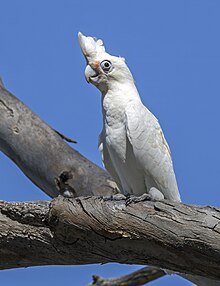Little corella
| Little corella | |
|---|---|

| |
| Blanchetown, South Australia | |
| Scientific classification | |
| Domain: | Eukaryota |
| Kingdom: | Animalia |
| Phylum: | Chordata |
| Class: | Aves |
| Order: | Psittaciformes |
| Family: | Cacatuidae |
| Genus: | Cacatua |
| Subgenus: | Licmetis |
| Species: | C. sanguinea
|
| Binomial name | |
| Cacatua sanguinea Gould, 1843
| |
| Subspecies | |
|
C. s. sanguinea | |
The little corella (Cacatua sanguinea), also known as the short-billed corella, bare-eyed cockatoo, blood-stained cockatoo, and little cockatoo is a white cockatoo native to Australia and southern New Guinea.[2] It was known as Birdirra among the Yindjibarndi people of the central and western Pilbara.[3] They would keep them as pets, or traditionally cook and eat them. The downy feathers are used in traditional ceremonies and dances where they adorn head and armbands.[4]
Taxonomy
The first recorded description of the species was by English ornithologist John Gould in 1843.[1] There are four subspecies as follows:[2]
- C. s. sanguinea
- C. s. normantoni
- C. s. transfreta
- C. s. gymnopis
- C. s. westralensis (Mathews 1917)
-
C. s. sanguinea, Northern Territory
-
C. c. gymnopis, South Australia
Description
The little corella is a small white cockatoo growing to 35–41 cm (14–16 in) in length and weighs 370–630 g (13–22 oz), with a mean weight of 525 g (1.157 lb).
Distribution and habitat
The nominate form, C. s. sanguinea is found in Northern Australia. C. s. normantoni is found on the Western Cape York Peninsula. C. s. transfreta is found in New Guinea. C. s. gymnopis is found in Central, Eastern, and South-eastern Australia.
Behaviour
Little corellas congregate in flocks of up to several thousand, which often include other birds such as galahs, sulphur-crested cockatoos and red-tailed black cockatoos. They generally roost in trees overnight, and fly off to feed in the early morning before returning in the late evening. Flocks will often fly many kilometres between their feeding and roosting areas, and in desert areas must also fly to watering holes twice a day, while corellas which live in coastal areas do not have to fly long distances to find water.[citation needed]
Call
The call consists of high pitched notes and screeches somewhat similar to the sulfur-crested cockatoo. Large flocks will call simultaneously and can create a deafening screeching sound audible from several kilometers away.[citation needed]
Breeding

Breeding occurs from May to October, and usually takes place earlier in the north of its range.[7] The nest is usually in a tree hollow, cliff cavity or termite mound.[7]
Feeding
Little corellas usually feed on the ground, however occasionally feed in trees and shrubs. They eat a variety of both wild and cultivated seeds and regularly feed on lawn grasses in urban areas. They frequently feed on cereal crops such as wheat, barley and maize and can become a considerable agricultural pest in some areas.[citation needed]
Playing
When little corellas play, they become very noisy. They have conversations with each other, fly around and also show off. Little corellas show off by hanging themselves upside-down with their feet, beaks or both.[citation needed]
Relationship to humans
In the state of South Australia, little corellas are considered "unprotected native fauna" and may be shot (without a permit), trapped or gassed (with a permit) by landowners. Permits are also available to take a limited number of little corellas from the wild each year for avicultural purposes.[10]
Threats
In July 2019, in a scene that was said to resemble a "horror movie",[11][12] about 60 corellas in Adelaide, South Australia,[13] died in a suspected case of poisoning, after "falling from the sky", bleeding from their mouths, and wailing. At least 57 of the birds were long-billed corellas, with a few of them being were short-billed corellas. It was hoped that whoever poisoned them would get traced after doing a report on toxicology, which could nevertheless take several weeks to complete, because in Australia, people were required to register if they purchase poisons, according to Sarah King, founder of Casper's Bird Rescue, who witnessed the deaths,[14] and also said that the type of poison was a slow one that takes several weeks to work. Additionally, the local Alexandrina council had beforehand called for short-billed corellas to be culled for damaging crops and chewing on streetlights, damaging built infrastructure such as buildings and sporting equipment, and displacing other native species of birds and bees, possums, and other organisms.[12]
References
- ^ . Retrieved 12 November 2021.
- ^ ISBN 978-1-4081-3575-4.
- ^ "Mystery Bird: Little Corella, Cacatua sanguinea". The Guardian. 25 September 2010. Retrieved 30 September 2023.
- ISBN 1-875946-54-3.
- ISBN 978-0-8493-4258-5
- ^ Little-Corella (2011)
- ^ ISBN 0-207-18013-X.
- ^ Sauders, D. A. "Measurements of the Little Corella from Kununurra, WA" (PDF). The Emu. CSIRO.
- ^ "Species profile—Cacatua sanguinea (little corella)". Queensland Government. Retrieved 22 August 2022.
- ^ "Take from the Wild Permits (unprotected)". Department for Environment and Water. Retrieved 22 August 2022.
- ^ Bote, Joshua (2019-07-12). "Dozens of birds fall from the sky like 'a horror movie.' They were poisoned, experts say". USA Today. Retrieved 2019-07-16.
- ^ a b Zhou, Naaman (2019-07-12). "'Like a horror movie': Dozens of corellas dead after falling from sky in suspected poisoning". The Guardian. Retrieved 2019-07-16.
- ^ Georgiou, Aristos (2019-07-12). "DOZENS OF BIRDS DROP OUT OF THE SKY IN SUSPECTED POISONING: 'THE SCENE LOOKED LIKE A HORROR MOVIE'". Newsweek. Retrieved 2019-07-16.
- ^ "Australia corella deaths: Dozens of birds found in suspected poisoning". The BBC. 2019-07-12. Retrieved 2019-07-16.
- Flegg, Jim (2002), Birds of Australia: Photographic Field Guide, Sydney: Reed New Holland
External links
- World Parrot Trust Parrot Encyclopedia - Species Profiles



